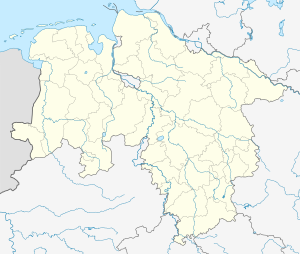Lauenburg bridge over the Elbe
Coordinates: 53 ° 21 ′ 59 ″ N , 10 ° 33 ′ 41 ″ E
|
|
||
|---|---|---|
| use | Road and rail bridge | |
| Convicted | Bundesstrasse 209 | |
| Subjugated | Elbe | |
| place | Lauenburg , Schleswig-Holstein | |
| construction | Steel truss bridge | |
| overall length | 517 m | |
| Number of openings | 8th | |
| Longest span | 104.61 m | |
| completion | 1951 | |
| location | ||
|
|
||
The Elbe bridge Lauenburg is (next to the Elbe bridge Geesthacht ) one of two existing fixed Elbe crossings between the federal states of Lower Saxony and Schleswig-Holstein . The combined road and rail bridge is located on the south-eastern edge of the old town of Lauenburg .
prehistory
Not far from this bridge was an important ford through the Elbe, known since the early Middle Ages , for example between the present-day communities Artlenburg and Schnakenbek . It was secured by the Ertheneburg on the north bank, after its destruction by the Lauenburg built in 1182 by Bernhard von Sachsen , which was strategically located at the mouth of the Delvenau into the Elbe .
history
The first construction of a pure railway bridge over the Elbe , with a sidewalk arranged on the side, took place in 1878 in the course of the Lübeck – Lüneburg railway line and replaced the traffic over the Lauenburg – Hohnstorf trajectory . The 448 meter long structure had, among other things, three stream openings with 100 meters span each, three flood openings with 40 meters span each and two rotary openings 14 meters wide. The bridge was designed for two tracks, but only one track was ever in operation. This railway bridge was last hotly contested in World War II. During the last days of the war it was controlled by Wehrmacht units of the Blumentritt Army Group under the command of General of the Infantry Günther Blumentritt for the retreat to Schleswig-Holstein until April 19, 1945 and on the same day under the pressure of the advance of the attacking British troops consisting of the 3rd Battalion of the Royal Tank Regiment and 4th Battalion of the King's Shropshire Light Infantry blown up. During the first demolition, the swing bridge contained in the bridge was destroyed. From the point of view of the defenders, three remaining arches of the bridge made a second demolition necessary, which also brought the success hoped for by those responsible. The bitter struggle for the Allied bridgehead at Lauenburg dragged on until 29/30. April 1945.
The reconstruction as a combined road and rail bridge took place until 1951. The structure connects Lower Saxony and Schleswig-Holstein in the course of the B 209 , which in turn joins the B 5 in Lauenburg on the bridge over the Elbe-Lübeck Canal . With a length of 517 meters, the bridge is longer than the previous one. It has eight openings, with the flow channel being spanned with a two-field strut lattice girder, each with a span of 104.61 meters. The approach bridges are steel solid wall girder structures with spans of around 53 meters.
Another road bridge over the Elbe between Schleswig-Holstein and Lower Saxony is the Geesthacht Elbe Bridge . It is also located east of Hamburg in the barrage of Geesthacht in the wake of the bus B 404 .
literature
- Erich Fiedler: Road bridges over the Elbe. A representation of the historical development of these bridges. Saxoprint, Dresden 2005, ISBN 3-9808879-6-0 .
Web links
| upstream | Bridges over the Elbe | downstream |
| Elbe bridge Dömitz (street) | Lauenburg bridge over the Elbe |
Geesthacht Elbe Bridge |

